By David Burke.
Kincora Boys’ Home was demolished last year. One part of the complex, however, was taken down and removed decades ago, the ‘tool shed’ at the rear of the premises.
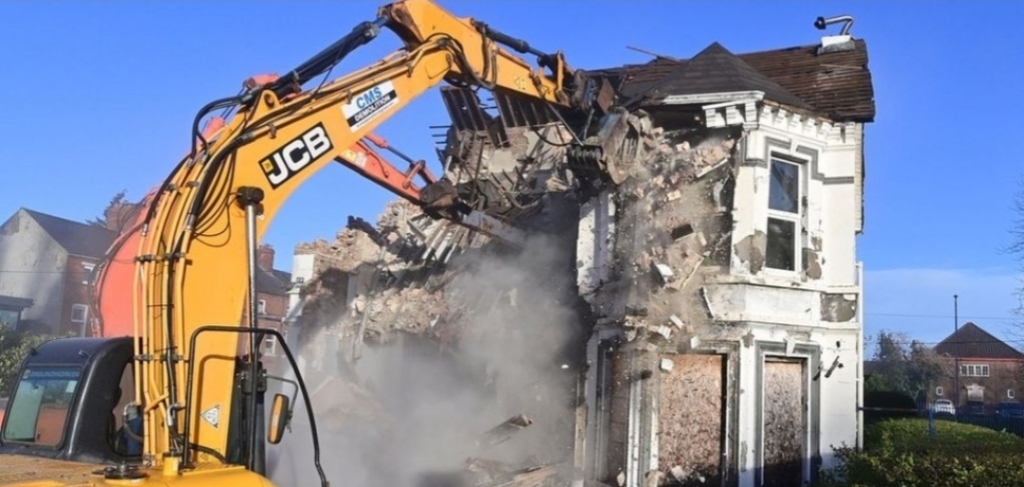
It hid what I fear is the darkest of Kincora’s many black secrets, one MI5, the RUC – and now – the PSNI, has been covering up for 50 years.
A Kincora survivor told me about the shed and the horrors it concealed a number of years ago. He broke down during his attempt to describe his experience and was unable to complete it. He has since received extensive counselling and is now in a position to reveal a little bit more about it.
1. THE ROTATING SAW

The hut contained a mattress which was used to cover a table. The mattress could be moved aside to reveal a split table beneath it. There was a mechanism on the side of the table which, when adjusted, caused a rotating saw to rise from below. A tree or a large plank of wood could have been cut on it.
Joseph Mains, the Warden of Kincora, was in the shed with the boy. Mains was a notorious paedophile who served a term of imprisonment for his brutal rape of children in the 1980s.

Mains had abused the Kincora boy sexually on numerous occasions prior to this incident. He now decided to terrify him. He did so by warning him that if he did not do as he was bid, and keep quiet about the abuse he was suffering, he would end up like the little boy with ‘the red hair’.
The former Kincora boy has touched upon this experience – fleetingly – in an affidavit I have seen and which is sworn by him. When I say ‘touch upon’, I mean that literally. He is still not able to address the experience without reliving the horror of it and backing away again. There is a lot more to emerge from this episode.

In the affidavit he described how he was sexually abused by Joseph Mains and that he
would talk to me and tell me things. He told me about a boy that had died in 1973 who he had been close to.
More information emerged later. Mains could drink heavily. During one drunken session, he stated that he was not responsible for the boy’s death but that had been part of the disposal team after the boy was dismembered on the saw table in the shed.
There is only one child who fits the description of the boy with the ‘red hair’, a 10-year old called Brian McDermott. He disappeared in September of 1973.

Joe Mains was never interviewed by the RUC about the boy’s murder, nor was his friend Alan Campbell, the RUC’s chief suspect in the case. This is because both men were working for Britain’s intelligence services.
2. JOE MAINS HAD A ‘RELATIONSHIP’ WITH THE CHIEF OF MI6
Joe Mains knew Sir Maurice Oldfield, the deputy chief of MI6, 1964-1973 and chief 1973-1978, and Co-ordinator of Intelligence Northern Ireland 1979-80.
MI6 and, later, MI5, ran a ‘honey pot’ blackmail operation with boys trafficked from Kincora Boys’ Home and other institutes. They were delivered to important Loyalist politicians and paramilitaries. Joe Mains ran the operation on behalf of MI6 and MI5.

James Molyneaux, Leader of the Official Unionist Party, 1979-96, was part of the Kincora paedophile group. He was a friend of William McGrath, the housefather of Kincora. McGrath was also the commander of Tara, a Loyalist paramilitary group. He was a gunrunner, inspiration for the founding of the UDA and an associate of the UVF and Red Hand Commando as well. Politically, he was close to Ian Paisley whom he knew since he – McGrath – was in his thirties – and Paisley was in his twenties. Paisley officiated at the wedding of both of McGrath’s children.
Between them, Mains and McGrath were plugged into every important Loyalist political and terror organisation in Northern Ireland.
The Hart Report into Kincora and other homes was published in 2017. In so far as Kincora is concerned, it is a shoddy piece of work which is littered with mistakes and unsustainable speculation. At one point, it even manages to contradict itself over vital facts. The author of the report, Sir Anthony Hart, was, by his own admission, a ‘lazy’ individual. He was held in a low esteem by many members of the Northern Bar.

There were, however, one or two valuable pieces of information hidden in the report. It confirmed that MI5 (which is attached to the Home Office) carried out an enquiry into the conduct of the former Chief of MI6, Sir Maurice Oldfield, in 1980. MI6 is Britain’s overseas intelligence service. It is attached to the Foreign Office. The Hart Report revealed that Mains and Oldfield had a ‘relationship’, presumably a professional one relating to the Kincora ‘honey pot’ operation.
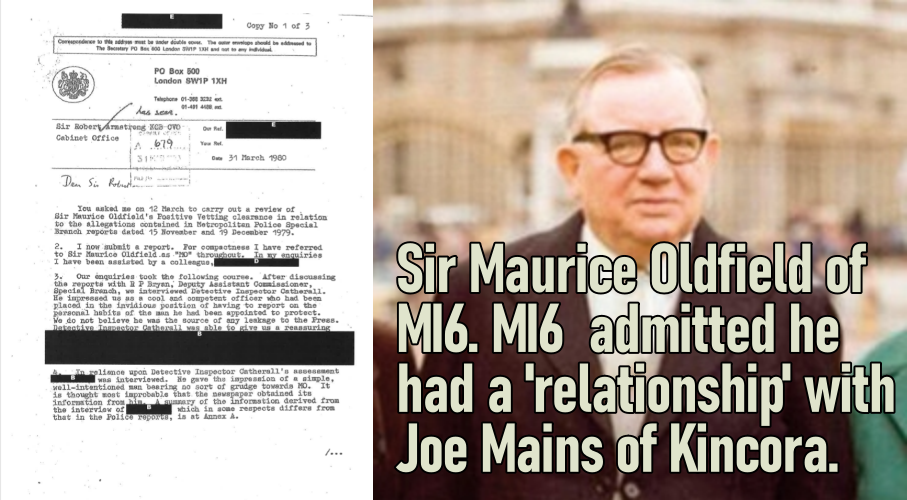
In 1980, MI5 discovered that Oldfield was a homosexual, a fact which meant that he had been lying about his sexuality for decades, especially during routine positive vetting sessions. In their eyes, this rendered him vulnerable to blackmail by rival foreign intelligence services. MI6 reviewed their files relating to the matter in 2011. According to Hart:
Officer G [of MI6] examined four ring binders with material relating to Sir Maurice Oldfield, including the 1980 MI5 investigation. Officer G made the following comments at the start of his note.
‘The relationship [Oldfield] had with Kincora boys’ home (KBH) in Belfast and subsequent “rent boy scandal” is, in my view the only remaining potential sensitivity in the papers.
‘The sensitivity being that [Oldfield]’s may have a link to (by association through his friendship of the KBH Head) the alleged crimes at the boys’ home. Given the current climate surrounding similar cases, it may at some point emerges as an issue.’ (Chapter 28, Paragraphs 619)
Hart noted that paragraph 5 of the MI6 review paper contained the following comment.
More worryingly is the small collection of papers in file three which relate to the relationship [Oldfield] had with the Head of the Kincora Boys’ Home (KBH) in Belfast.
Hart concluded that this was not evidence of MI6 involvement in Kincora because Officer G had made a mistake and was merely referring to allegations about the relationship Oldfield had had with the “KBH Head”. (620)
Neither MI6 nor the Hart Report quoted any contemporaneous report alleging a friendship between Oldfield and the Warden of Kincora, Joseph Mains, the only man who fits the description of “KBH Head”.
3. OTHER BRITISH AGENTS WHO WERE PAEDOPHILES
Joe Mains and his colleague William McGrath, the ‘housefather’ of Kincora, were agents of MI6 and, later, MI5. They switched from MI6 to MI5 because MI5 began to dominate operations in Northern Ireland as the Troubles persisted.

Capt. Brian Gemmell, a military intelligence officer who reported to MI5, states on the recently released Lost Boys documentary with absolute certainty that McGrath was a British agent.
McGrath spent at least ten years boasting that he was connected to British intelligence.
Mains and McGrath ran MI5 and 6’s ‘honey pot’ blackmail operation at Kincora.

Eric Witchell ran one of the other homes. It was called Williamson House. Witchell furnished young boys – some only 6 – to paedophiles. He was a friend of Mains and McGrath.
Witchell is still alive. He is the only person known to support the findings of the Hart Report. He cites it to allege that survivors are liars. He claims that his rape of the boys at Williamson House, some of whom committed suicide, was an expression of his love for them.
4. CHILD ABUSE WHICH ENDED IN MURDER
There is one palpable candidate who fits the profile of the boy with the ‘red hair’ mentioned by Mains to the Kincora survivor in the shed at Kincora. His name was Brian McDermott. He was murdered in 1973.
Brian McDermott is one of Belfast’s five missing boys from the Troubles.
Mains was abusing this unfortunate child, according to what he told the Kincora boy in the tool shed at Kincora.
It was the practice of the paedophile network of which Mains was a leading figure to share boys. Mains passed boys to paedophiles such as Alan Campbell, John McKeague, Ken Larmour, William McGrath and Raymond Semple.
5. ALAN CAMPBELL, SUSPECTED CHILD KILLER.
Alan Campbell was born in Belfast on 7 August 1949, into a staunchly Presbyterian home. He converted to Free Presbyterian Christianity on 19 September 1965, in the Ravenhill Free Presbyterian Church after listening to a sermon by Ian Paisley. He became very close to Paisley for a long time.
Campbell’s grandmother was a British Israelite, a belief to which he subscribed, i.e., that the Protestants of Northern Ireland were one of the Lost Tribes of Israel.
William McGrath was also a British Israelite. McGrath and Paisley were British Israelites too.
So close was Campbell to Paisley, that he served on his Constitution Defence Committee (as did John McKeague, the serial killing leader of the Red Hand Commando).
Campbell held other rather whacky notions such as that of ‘Kingdom Identity’. This asserts that Israel, not the church, is the bride of Christ, in contradiction to the teachings of the Westminster Confession of Faith.

Campbell was a founding member of Tara, the paramilitary organisation led by McGrath.
He was also a founding member of the Protestant Ulster Party (PUP), established by Paisley which transformed into the DUP.
Campbell opposed inter racial sex and marriage. In a lecture in the US, he stated that the races had separate origins and distinct biblical destinies and that black people were the ‘beasts of the field’ referred to in the Bible. He supported apartheid in South Africa, was critical of Unionist politicians meeting Nelson Mandela and called Desmond Tutu a ‘little black man’.
Campbell and John McKeague were key figures in the Shankill Defence Association (SDA), the forerunner to the UDA. Both were deeply violent and sadistic men. McKeague was the commander of the Red Hand Commando terror group. He enjoyed torturing and murdering Catholics in Belfast’s ‘romper rooms’. It is more than likely that Campbell joined him in some of these kidnapping and torture sessions.
Author Henry McDonald described Alan Campbell in his books as the ‘Demon Preacher’, and asserted he was a British Intelligence asset too.
6. ALAN CAMPBELL AND THE ‘LOST BOYS’ DOCUMENTARY
The Lost Boys documentary has linked the murder of Brian McDermott to the paedophile ring that swirled around Kincora.
The thesis put forward in the documentary is, I believe, 100% correct, namely that five boys were kidnapped by members of the Kincora paedophile gang.

The Lost Boys was commissioned by BBC NI but when it realised that the makers had concluded that people involved in the Kincora scandal were identified as the culprits behind the disappearance – and obvious murders – of the boys, they refused to broadcast it. Readers of this article are not likely to see the documentary on television, at least not for the foreseeable future. It will certainly not be shown on the BBC which is refusing to broadcast it because it does not align with the Hart Report. Hart determined in his report that MI5 and MI6 had not known that the boys at Kincora were being abused.
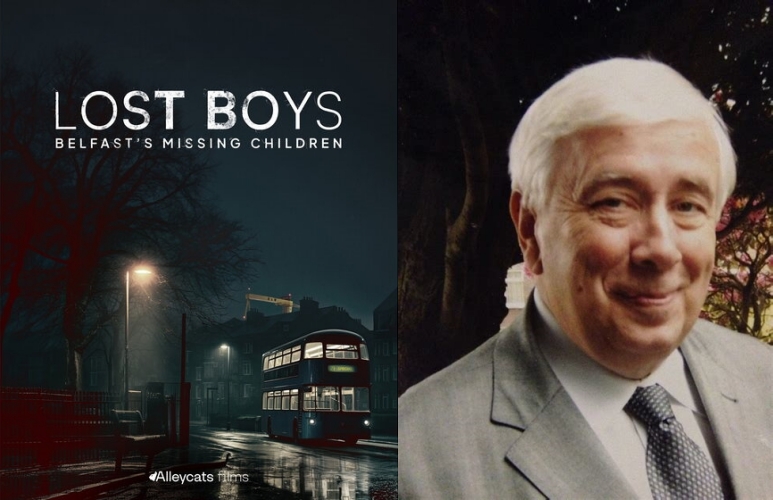
Campbell was the chief suspect the RUC had in mind for the McDermott murder.
Campbell was a known abuser who had come to the attention of the RUC previously. On 3 November 1970, Campbell sexually assaulted a Bawnmore home resident at a flat owned by Ken Larmour, in Belfast. Larmour was another paedophile. Campbell appeared at Belfast Magistrate’s Court in May 1971. The case was dismissed after Cllr Margaret Miskimmin of Paisley’s Protestant Unionist party (PUP) gave him an alibi. Miskimmin’s evidence was perjury. The RUC discovered later that Campbell had asked Miskimmin to provide him with an alibi. He was never charged with procuring perjured evidence.
He had another run in with the police but his case went missing inside the system.
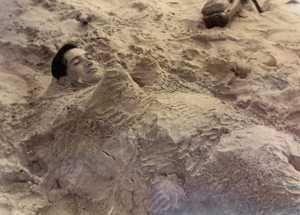
Ken Larmour was the clerk to the Court. He was also a close friend of Campbell. He let Campbell use his flat to rape boys. Larmour too seems to have become a British agent and helped Campbell slip off the hook by manipulating court dates and losing the Campbell file.
Later, documents relating to Campbell’s crimes disappeared in an alleged bombing incident. This type of coincidence beggars belief. It is far more likely that RUC and British intelligence officers used the information to blackmail and recruit Campbell as an agent.
As demonstrated by official documents cited in the Lost Boys, Campbell threatened to kill at least one boy with a knife if he ever spoke about the sexual abuse Campbell had perpetrated upon him.
Campbell is also a suspect in the murder of the other boys in the Lost Boys documentary.
He led a charmed life and, after 1971, was never arrested again.
Paisley was fully aware of Campbell’s rape of children and that Miskimmin had committed perjury to save him, and denied both of them membership of the DUP. He was otherwise content to let Campbell continue to abuse children.
Campbell left the Free Presbyterian Church of Ulster after which he no longer promoted the views of his former friend Ian Paisley, nor his literature.
7. THE UNSOLVED MURDER OF BRIAN McDERMOTT
On Sunday 2 September 1973, ten-year-old Brian Douglas McDermott left his home at Well Street, South Belfast, to go and play in nearby Ormeau Park with some friends.
Ormeau Park was a notorious hunting ground for Belfast’s paedophiles. Brian was also a cub boy scout. The scouting movement was riddled with paedophiles.
Brian left for the park at 1 p.m. It was a ten minute walk from his home. His parents told him to return by 2:30 p.m. for his Sunday lunch. He was due to return to school the following Tuesday.
Brian was the youngest of five children (three boys and two girls). He was described as quiet, timid, and ‘very, very deep’. He was bullied quite a lot at school.
Some of his friends were playing in the park. One of them was walking his dog. He described Brian as being his normal, happy self when he bumped into him. An hour later, Brian was sitting on a swing. A friend asked him if he wanted to play. He seemed unhappy, shook his head and walked off through a gap in a wire fence towards an area of shrubs and trees.

He was never seen again.
I believe the change in his mood was because a paedophile had just approached him and ordered him to go to a rendezvous point. Brian remained on the swing in a gloomy mood for a while after the paedophile left. The unfortunate child knew that he was going to be sexually abused shortly.
Something went terribly wrong after the paedophile abused the boy. The most likely explanation is internal bleeding post rape which resulted in the death of the child.
Alan Campbell is the only realistic suspect for the rape and murder. He was a paedophile. He was violent. He was a close friend of Joe Mains who has admitted disposing of the body. He was also a British agent and therefore a protected person. Significantly, if arrested, he was in a position to blow the Kincora operation apart.
John McKeague had similar violent impulses but is not a suspect as he was interned at the time of the abduction and murder.
8. THE MISSING CHILD
When Brian failed to return home, his father, Edward, alerted the RUC.
The RUC searched the area close to his home, including derelict buildings.
Six days later, a witness reported having seen what appeared to be a body in a bag in the nearby River Lagan. A search led to the discovery of a hessian bag with the charred remains of Brian’s body inside it close to the Annandale embankment. Both of his legs were missing, as well as one of his arms. His body was so badly burned that fingerprints from the hand of the remaining arm had to be used to identify his little body. The fingerprints matched those on his school books and confirmed that the child was young McDermott.
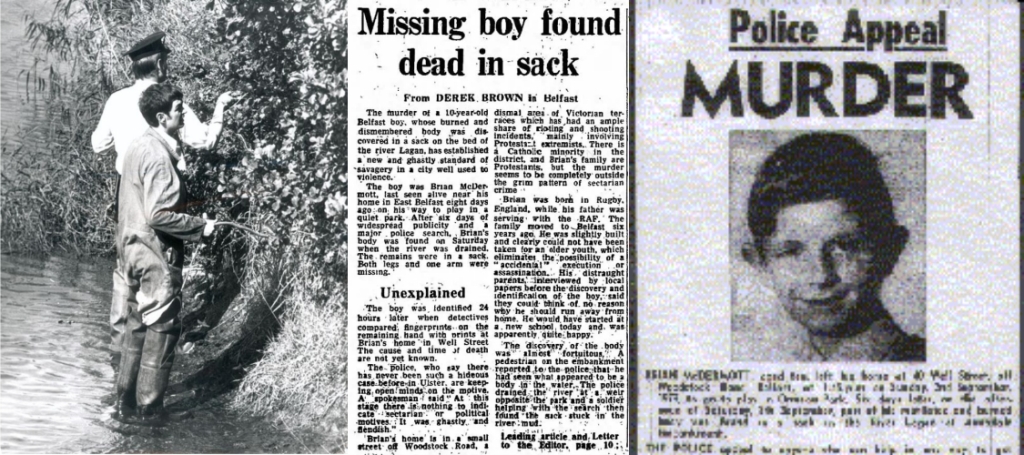
The authorities lowered the waters to the river’s tidal weir in a search for his missing limbs, but to no avail.
I believe that on this occasion Campbell went too far and inflicted fatal injuries upon the child and that he died as a result. His body was then taken to Kincora where Mains and Campbell cut the limbs from his dead body on the table with the rotating saw. They then attempted to burn the body and dropped the body parts into two hessian bags and threw them into the Lagan.
The ‘tool shed’ at Kincora was also where Mains stored potatoes. Potatoes are typically kept in hessian bags.
The RUC investigated the presence of a tan coloured car near the riverbank acting suspiciously. Mains drove just such a car.
When all these facts are brought together, the revelation by the boy Mains took into the shed assumes great credibility.

I fear that as the RUC closed in on Campbell, he or Mains, or McGrath, went to MI5 for protection. The problem would have been reviewed by the Director and Controller of Intelligence for NI, Denis Payne and Ian Cameron of MI5. It is inconceivable that they did not alert Sir Michael Hanley, D-G of MI5, 1972-78, about the awkward murder and the threat it posed to a multiplicity of MI5’s operations in the North.
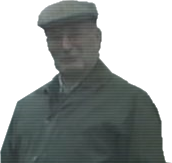
9. COLIN WALLACE
Colin Wallace was a public relations officer serving with the British Army at its HQ at Thiepval barracks, Lisburn, (HQNI). Covertly, he had a second role: he worked for the Army’s psychological operations unit (PSYOPS). The PSYOPS arm was known as Information Policy Unit (IPU). It was based at HQNI.
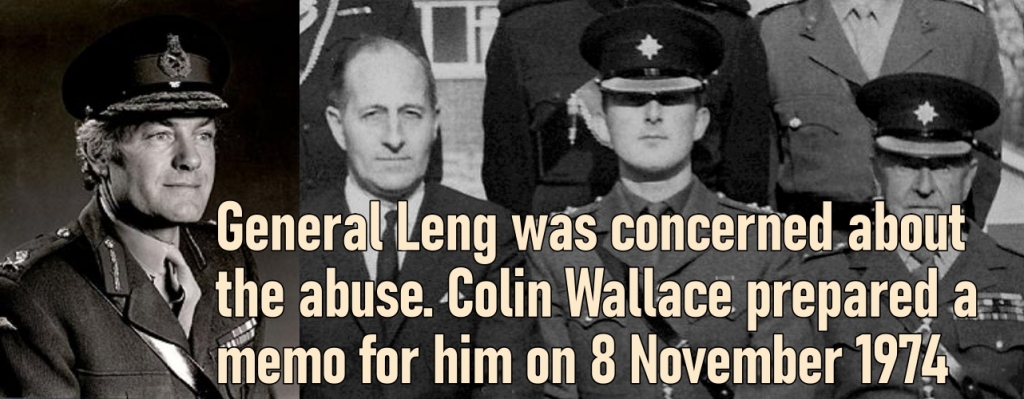
Dirty tricks were deployed in 1975 to oust Colin Wallace from his job after he had attempted to draw the media’s attention to a number of issues including the activities of William McGrath, the paedophile housefather at Kincora Boys’ Home. McGrath, like Campbell and Mains, was a prolific and brutal child rapist.
Wallace was also deeply concerned about the abduction and murder of Brian McDermott.
10. THE BRIAN McDERMOTT CHILD MURDER MEMO.
General Peter Leng commanded the British army in NI in 1974. He was aware that McGrath and other Loyalist paramilitaries were paedophiles. He asked Col Geoffrey Hutton what was going to be done about it. Hutton asked Colin Wallace for a memo on the issue. On 8 November 1974, Wallace produced a memo for Hutton (hereafter ‘The Brian McDermott Child Murder Memo’). It highlighted the abuse at Kincora and at other children’s homes. One part of it focused on the horrific murder of Brian McDermott.
Wallace indicated that members of John McKeague’s circle were implicated in the murder of McDermott. He advised that:
Those responsible for the murder of Brian McDermott must be brought to trial before another child is killed, and if it can be proved that there is a connection with this homosexual group, then the RUC must be forced to take action irrespective of who is involved.
11. WALLACE BEGINS TO SUSPECT THE PAEDOPHILE RING IS BEING PROTECTED BY THE POLICE.
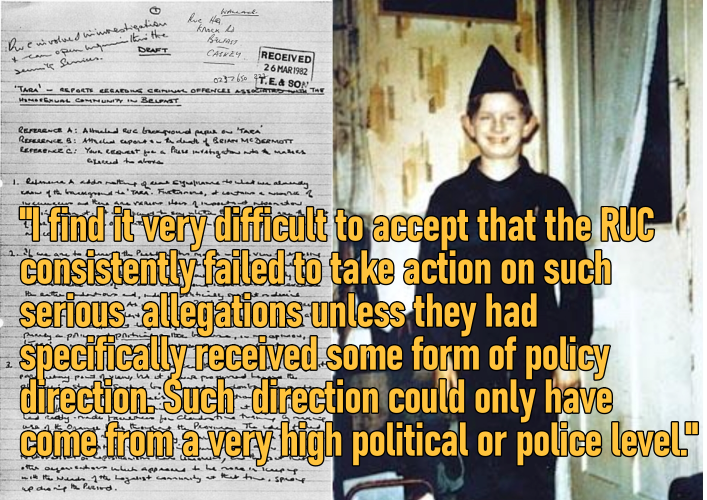
Under the heading ‘conclusions and recommendations’ in the Brian McDermott Child Murder Memo, Wallace stated:
I find it very difficult to accept that the RUC consistently failed to take action on such serious allegations unless they had specifically received some form of policy direction. Such direction could only have come from a very high political or police level. If that is the case then we should be even more wary about getting involved.
Wallace recommended that the Army should enjoin the RUC and responsible journalists to investigate the scandal.
Had Wallace’s recommendation been accepted, the Kincora scandal might have erupted in late 1974.
Two further boys, John Rogers (13) and Thomas Spence (11), disappeared a few weeks later – on 24 November 1974.
A Few weeks later Wallace was dismissed from his job. Sir Michael Hanley was personally and directly involved in rigging the appeal Wallace made against his dismissal. In an ebook entitled ‘Operation Clockwork Orange’ I have reproduced correspondence involving Hanley in the plot against Wallace. (It can be found on this website.)
12. ‘.. LINKING THE MPS WITH LOYALIST PARAMILITARY FIGURES INVOLVED IN HOMOSEXUAL PROSTITUTION AT A CHILDREN’S HOME IN BELFAST’.
After his dismissal in 1975, Wallace wrote to his former boss at HQNI. The letter referred to ‘homosexual prostitution at a children’s home in Belfast’. The relevant extract reads as follows:
My concern now is that there may be an attempt by the Ministry [of Defence] to deny any form of official ‘dirty tricks’ organisation existed within the Security Forces. For example, in the Ministry’s summary of my oral representations made [at an employment tribunal] to John Groves and Mr Fairbairn on 10 May reference is made in paragraph 3 to ‘actions’ which I was asked to launch during the [1974 Ulster Workers Council anti-power-sharing] strike. The word ‘actions’ appears to have been used by MOD to conceal the fact that I referred to the attempts made by the Security Service [i.e. MI5] to discredit various Loyalist politicians, including the Rev Ian Paisley [of the DUP], by the use of forged documents and by linking the MPs with loyalist paramilitary figures involved in homosexual prostitution at a children’s home in Belfast.
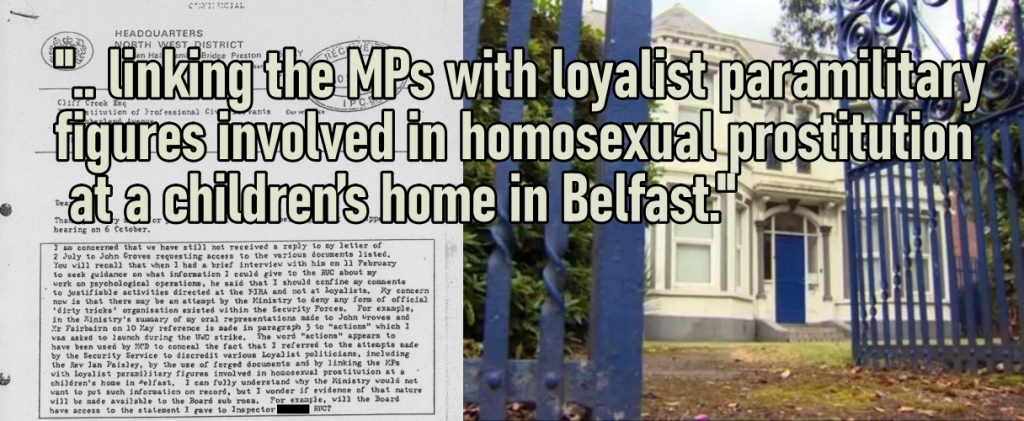
13. WALLACE’S CLOCKWORK ORANGE NOTES AND A REFERENCE TO ‘A PROSTITUTION RING SUPPLYING BOYS TO HOTELS IN BELFAST AND BANGOR’.
Wallace has other documents which expose what was known in the mid-1970s.
Wallace was asked by MI5 to assist a dirty trick scheme codenamed ‘Operation Clockwork Orange’. Towards this end, he was provided with information which he recorded in his notebook. Forensic examination has proven that his notes are authentic. In December 1974 Wallace recorded the following:
Joseph Mains may be extensively involved in a prostitution ring supplying boys to hotels in Belfast and Bangor. The hotels include: Girton Lodge, Park Avenue; Stormont; Europa and the Queen’s Court in Bangor. [John] McKeague is said to use the Royal Avenue Hotel for the same purposes. Bearing in mind that the East Belfast UDA leadership use the Girton Lodge and the Park Avenue for their meetings, it is simply [not] credible that they did not know what is going on there. Note: Mains has a brother in the RUC. He also has a questionable relationship with Belfast Corporation Welfare Chairman (Cardwell) and Legal Adviser (Young).

14. FRAMING AN INNOCENT MAN
Instead of pursuing Campbell, an attempt was later made to frame one of his brothers who was coerced by the RUC into making a confession in 1976. It was later dismissed as a fabrication.
15. THE DISPOSAL OF EVIDENCE
The destruction of the shed at Kincora took place shortly after the media exposed the scandal at Kincora. A wealth of potential evidence was destroyed.
The teeth of the rotating saw and its casing must have contained blood and other DNA evidence. The roof and wall could have been splattered with blood, flesh and bone.
There are people who were friendly with Mains who are still alive who might yet tell what they know about the shed. They include Eric Witchell who lives in London.
If Mains was prepared to talk about the dismemberment of the boy with ‘red hair’ while drunk, he may have recounted the event on numerous occasions to others.
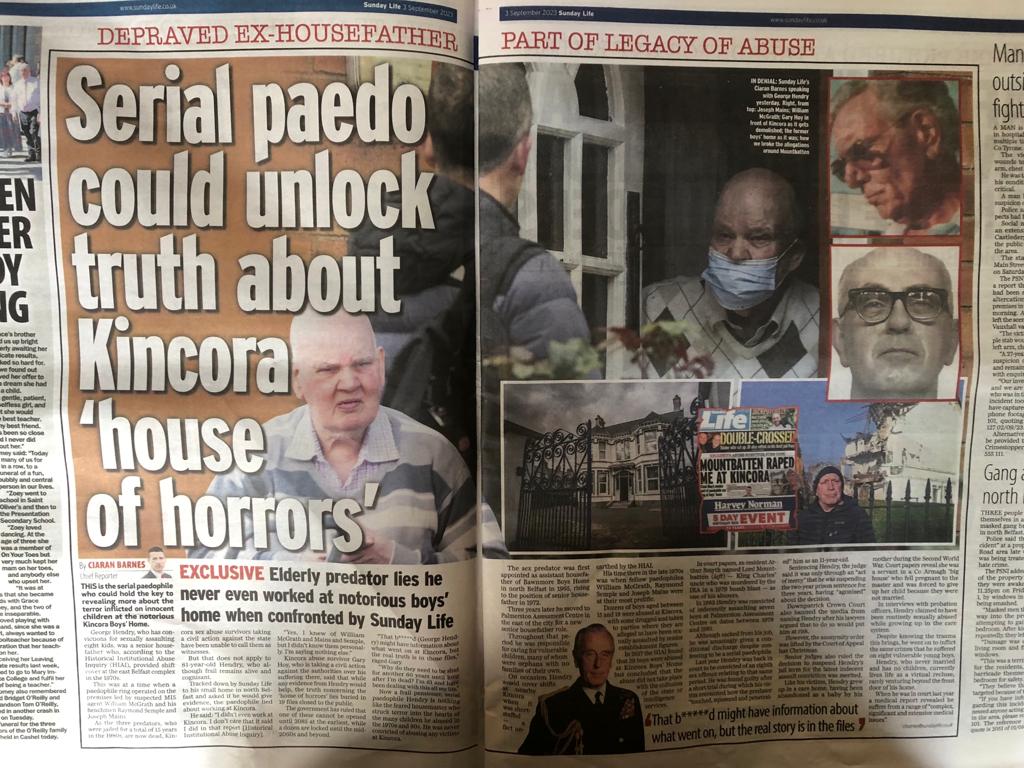
George Hendry is a convicted paedophile. He lives in Belfast. He worked at Kincora in the 1970s from time to time. He took over the building after the media exposed the scandal in January 1980. Hendry is still alive.
He should be asked if he knew there was a rotating saw in the shed.
Did he ever ask Mains what it was for?
Did he ever see anyone else near it? If so, what were they doing?
Who decided to demolish the shed?
Who actually demolished it?
Who held the keys to it?
16. GEORGE CASKEY
The RUC covered-up the Kincora scandal. The chief investigator of Kincora for the RUC was George Caskey who was ordered to hide the truth. Yet, he was so repulsed by what he discovered that he leaked information to investigative BBC NI journalist Chris Moore. Caskey told Moore that two senior Northern Ireland Office (NIO) officials, Peter England and John Imrie abused children at the home.
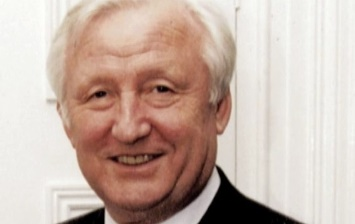
17. CAMPBELL’S SUCCESSFUL CAREER AS A SCHOOL TEACHER, PASTOR AND WRITER.
After his trouble with the RUC in 1971/2, Alan Campbell was never bothered by them again, or their successor body, the PSNI.
He was employed as a teacher of religion at a school in Belfast.
He went to South Africa where he engaged in what he called ‘missionary work’.
He went to America where he spoke to white supremacist groups including the Klu Klux Klan.
He wrote a successful booklet entitled ‘Five Things Every Ulster Protestant Needs to Know’. He was a prolific writer and, all told, published about 40 pamphlets.
He was editor of ‘Rome Watch’ pamphlet and ran his own church where he acted as a pastor.
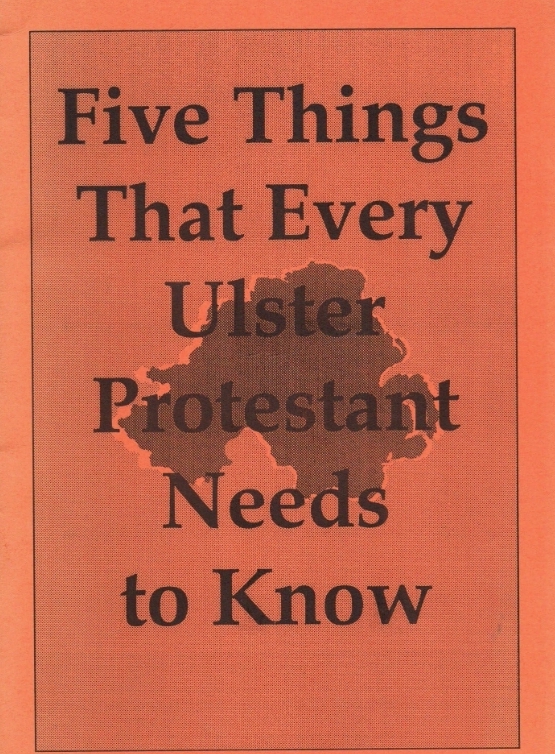
18. CAMPBELL, THE LVF, ORANGE VOLUNTEERS AND PIPE BOMBING THE GAA.
Officers in MI5 and the RUC opposed the peace process in the 1990s because they believed they could yet defeat the IRA. MI5 influenced, if not fully controlled, the Loyalist Volunteer Force (LVF) through it’s leader Billy Wright, one of their agents. Campbell was involved with the LVF too. The LVF opposed the peace process.
Billy Wright and the LVF carried out assassination operations in collusion with MI5.
Campbell was present during agitation at Drumcree when the Orange Order fought the police in their attempts to march through Nationalist communities despite a marching ban.
After the signing of the Good Friday Agreement (GFA) in 1998, Campbell, now in his early fifties, and others, including DUP politicians, set up the Orange Volunteers, an armed group opposed to the GFA (See Sunday Life: https://x.com/TheSundayLife/status/1708388955970838720?t=xWgSiVXoNLi-5HdeGJ58Mw&s=08
The Orange Volunteers carried out pipe bomb attacks on the GAA targets and the homes of nationalists in Derry and Antrim. Pastor Clifford Peeples and other OV leaders were arrested and convicted. Campbell was left alone by the RUC and MI5.
In his later years, Campbell was sometimes challenged about his role in the abuse of boys. His habit was to turn his back and rush back to his home.
He lived in Fortwilliam Grange, north Belfast, and died a free man in 2017, aged 67. About 40 people attended his funeral in Belfast.
For additional information on Alan Campbell, see the following brilliant article by Kincora expert Hugh Jordan: https://m.sundayworld.com/crime/irish-crime/special-report-suspected-child-killer-preacher-alan-campbells-deal-with-the-devil/a1177400993.html
19. AN OPEN FESTERING WOUND
The Kincora survivor who spoke to me about the rotating saw was abandoned by his parents as a very young child. The people who were meant to care for him raped and abused him. They were not ordinary paedophiles, but also vicious and murderous Loyalist terrorists. It should come as no surprise that he is still terrified and lives in great fear for his life. He does not trust the police. He has moved his accommodation in recent times on account of fear. The Kincora story is not historical. The pain and fear persists to this day. It is truly an open wound.

David Burke is the author of three books published by Mercier Press: –
‘Deception & Lies, the Hidden History of the Arms Crisis 1970’, and;
‘Kitson’s Irish War, Mastermind of the Dirty War in Ireland’ which examines the role of counter-insurgency dirty tricks in Northern Ireland in the early 1970s, and;
‘An Enemy of the Crown, the British Secret Service Campaign against Charles Haughey’, which was published on 30 September 2022.
These books can be purchased here:
https://www.mercierpress.ie/irish-books/kitson-s-irish-war/
https://www.mercierpress.ie/irish-books/an-enemy-of-the-crown/
https://www.mercierpress.ie/irish-books/deception-and-lies
Operation Clockwork Orange, an ebook, can be found on this website.
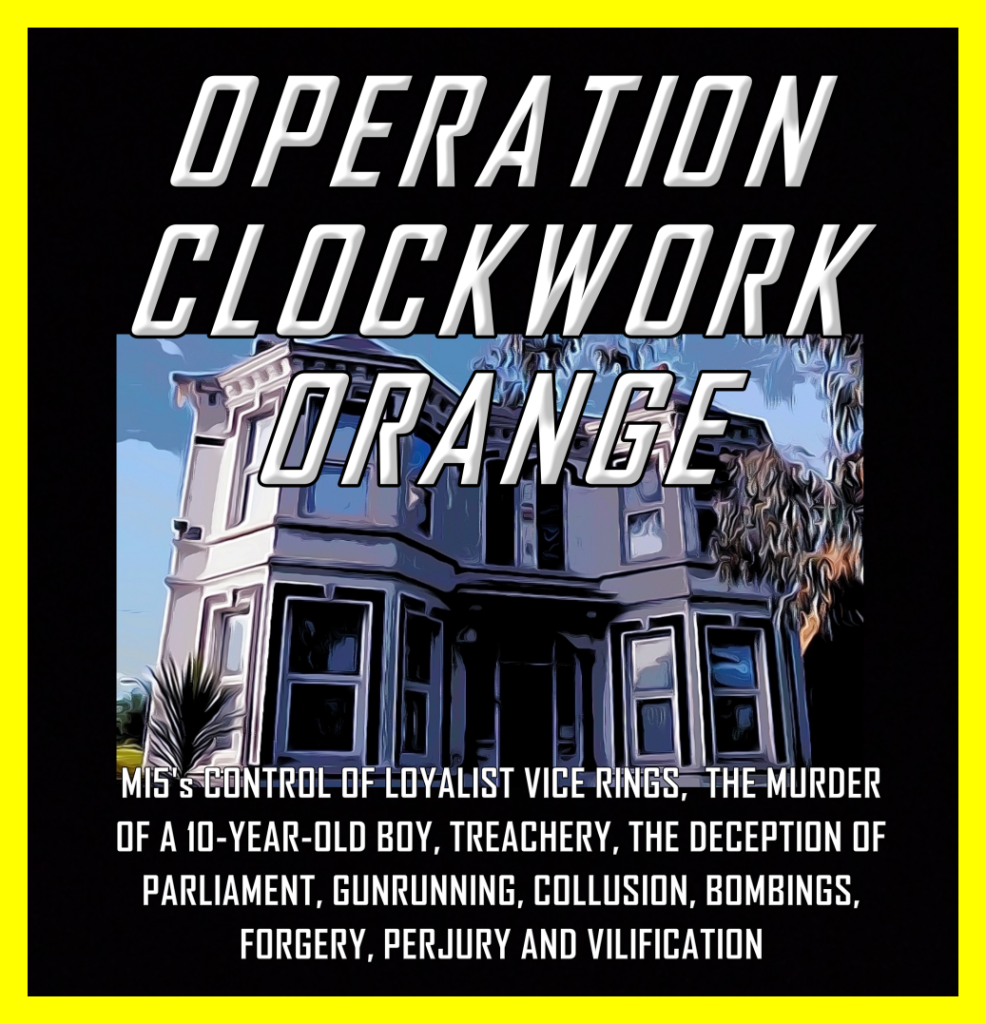
The Mountbatten Dossier, an ebook can also be found on this website.


